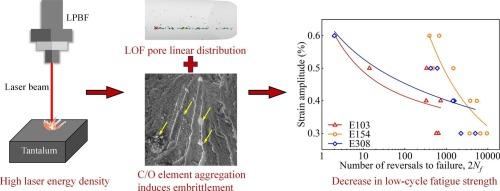激光能量密度对激光粉床熔融钽低周疲劳性能的影响
IF 6.8
2区 材料科学
Q1 ENGINEERING, MECHANICAL
引用次数: 0
摘要
激光粉末床熔融钽(LPBF-Ta)在骨科植入物和航空航天工业中具有重要的应用潜力。然而,低周疲劳(LCF)失效的风险仍然是一个关键的挑战,尚未得到充分解决。本研究首次阐明了不同激光能量密度对LPBF-Ta的微观组织和缺陷的影响,以及它们对其疲劳寿命响应和失效机制的重要影响。具体而言,研究结果表明,优化激光能量密度可以有效控制LPBF-Ta的微观结构和缺陷形态,显著提高LPBF-Ta的LCF寿命。在循环载荷作用下,低角晶界处的高初始位错密度和缺乏熔合(LOF)孔隙优先驱动裂纹的形核和扩展,是疲劳性能退化的潜在因素。与低激光能量密度下形成的随机分布的LOF孔不同,高激光能量密度下溅射诱导的LOF孔沿建筑方向呈线性分布,形成垂直排列的孔链。此外,富含碳和氧元素的飞溅破坏了层间结合,导致局部脆化,有害地降低了疲劳寿命。这些发现和见解为理解LPBF-Ta的LCF行为和确保其安全的工程应用设计提供了重要的参考。本文章由计算机程序翻译,如有差异,请以英文原文为准。

The influence of laser energy density on the low cycle fatigue behavior for laser powder bed fused tantalum
Laser powder bed fused tantalum (LPBF-Ta) holds significant potential for applications in orthopedic implants and aerospace industries. However, the risk of low-cycle fatigue (LCF) failure remains a critical challenge that has yet to be adequately addressed. This study is the first to elucidate the effects of varying laser energy densities on the microstructure and defects of LPBF-Ta, as well as their crucial influence on its fatigue life response and failure mechanisms. Specifically, the findings demonstrate that optimizing laser energy density can effectively control microstructure and defect morphology, significantly enhancing the LCF life of LPBF-Ta. High initial dislocation densities at low-angle grain boundaries and lack-of-fusion (LOF) pores preferentially drive crack nucleation and propagation under cyclic loading, representing potential factors for fatigue performance degradation. In contrast to randomly distributed LOF pores formed under insufficient low laser energy density, LOF pores, induced by spatter under high laser energy density, are linearly distributed along the building direction, forming vertically aligned pore chains. Additionally, the spatter enriched with carbon and oxygen elements destabilizes interlayer bonding, causing localized embrittlement and detrimentally reducing the fatigue life. These findings and insights provide critical references for understanding the LCF behavior of LPBF-Ta and ensuring its safe engineering application design.
求助全文
通过发布文献求助,成功后即可免费获取论文全文。
去求助
来源期刊

International Journal of Fatigue
工程技术-材料科学:综合
CiteScore
10.70
自引率
21.70%
发文量
619
审稿时长
58 days
期刊介绍:
Typical subjects discussed in International Journal of Fatigue address:
Novel fatigue testing and characterization methods (new kinds of fatigue tests, critical evaluation of existing methods, in situ measurement of fatigue degradation, non-contact field measurements)
Multiaxial fatigue and complex loading effects of materials and structures, exploring state-of-the-art concepts in degradation under cyclic loading
Fatigue in the very high cycle regime, including failure mode transitions from surface to subsurface, effects of surface treatment, processing, and loading conditions
Modeling (including degradation processes and related driving forces, multiscale/multi-resolution methods, computational hierarchical and concurrent methods for coupled component and material responses, novel methods for notch root analysis, fracture mechanics, damage mechanics, crack growth kinetics, life prediction and durability, and prediction of stochastic fatigue behavior reflecting microstructure and service conditions)
Models for early stages of fatigue crack formation and growth that explicitly consider microstructure and relevant materials science aspects
Understanding the influence or manufacturing and processing route on fatigue degradation, and embedding this understanding in more predictive schemes for mitigation and design against fatigue
Prognosis and damage state awareness (including sensors, monitoring, methodology, interactive control, accelerated methods, data interpretation)
Applications of technologies associated with fatigue and their implications for structural integrity and reliability. This includes issues related to design, operation and maintenance, i.e., life cycle engineering
Smart materials and structures that can sense and mitigate fatigue degradation
Fatigue of devices and structures at small scales, including effects of process route and surfaces/interfaces.
 求助内容:
求助内容: 应助结果提醒方式:
应助结果提醒方式:


